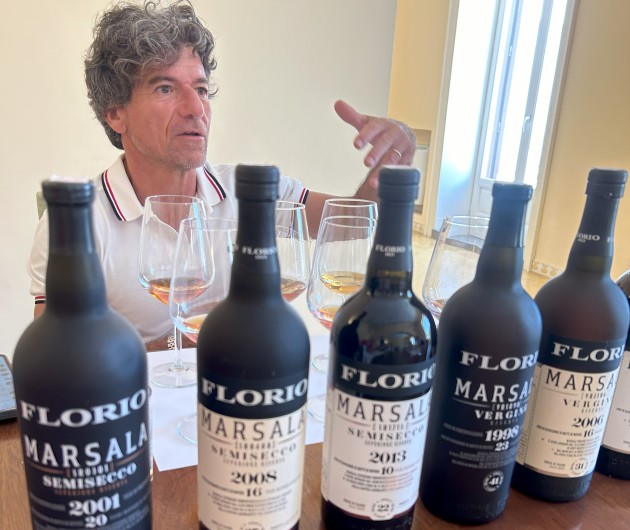
Friday read: Rediscovering the magic of Marsala
Visiting Sicily as part of the Duca di Salaparuta Group’s 200-year celebrations this month included a trip to their world-famous Florio cellars. This served as an apt reminder that Marsala is more than an ingredient in your tiramisu, more than a bottle of something strong in Granny’s drinking cabinet; this is a serious wine, with serious pairing potential. And, as such, perhaps it’s time to rediscover this under-appreciated gem.
The fortified Marsala wines, made dry or sweet in the region of Sicily that give then their name, can be made from several regional grapes. However, Cantine Florio, the first Italian company to produce Marsala (since 1833), prides itself in the use of just one grape, Grillo. It’s an indigenous white variety that is perfect for Marsala; yielding wines with structure, good alcohol levels and high acid, important for its ageing potential.
Moreover, Florio’s cellars face the sea, with barrels ageing either closer to or further from the shoreline. This method gives the wines that are stored among these hallowed halls a brackish quality if nearer the sea, versus spicier notes inland. Combine this with a unique map on each Florio Marsala bottle, locating the barrel and its place in the cellar, and you have a magical formula.
Marsala is unlike other fortified wine styles such as sherry in which casks are blended between each other (the solera system) and Port which is usually red and typically sweet. Florio’s Marsala wines are different to those above; they remain a single cask expression, giving each barrel a unique flavour that cannot be replicated elsewhere.
The cellars, which contain more than 3,000 barrels and six million litres of Marsala are redolent of history, oak, dried fruits and resin. Tommaso Maggio, oenologist here, leads the pace; tapping random barrels as we walk to gauge each cask’s fill level versus the angel’s share. He is an arresting figure, giving off the energy of a museum curator entrusted with priceless artefacts, which these artisanal products surely are. Tap, tap, tap…
“Walking around the cellars is like eating, a part of my life; if you pay attention, you can hear the sound from the smallest barrel, I know then the wine is alive,” he says.
When Tommaso spies older vintages, such as a 1939 barrel, he can imagine the long since passed winemaker: “For me tasting those wines is like a fairy tale.”
It’s hard not to be spellbound by the sheer scale and history of the barrels. However, away from the cellars what part can these wines play in the wider drinks market?
As wine fashion goes, higher alcohol is a turn off for many. But if showcased by restaurants and sommeliers, there is, I believe, great potential for Marsala wines for food pairing. From the drier Vergine styles, to pair with meaty dishes, to the semisecco (sweeter) expressions which can pair with a host of more exotic spiced meals.
To help understand the context of how these wines could be enjoyed it was interesting to taste Florio’s table wine first, rather than the fortified. Vino Florio was a brisk citric sensation, this being especially pertinent considering that it’s the blueprint base wine that all other Florio Marsalas evolve from. The Vino was a dry wine that offers great pairing opportunities, good as an aperitivo but a full-bodied white that can stand more robust white fish and meats.
We tasted six Marsala wines from the Vergine (2010, 2006, 1998), a dry style with often nutty, savoury notes; to the Marsala Superiore Semisecco (2013, 2008, 2001), a semi-sweet wine with around 70g/l residual sugar.
At around 19% abv these wines are strong, but paired beautifully with classic Sicilian fare, including fish risottos, cheese and sweet treats.
I asked Tommaso which wine he would choose to drink after a bad day? “Every day is a good day but usually its Vino Florio or Vergine styles,” came his reply.
Education is key to understanding not only the process of Marsala making but how its ageing contributes to the rainbow of styles produced. Potential funding by the domestic government is important and Tommaso is keen to push this. However, his passion should also be part of the potential for the cultural proliferation of these wines. With any luck Tommaso will achieve his next dream of opening a new room on site where experimentation with different Marsala barrel collaborations (such as whisky and rum ageing) can be showcased.
“My main hope is that the government will help finance these wines and help people to discover Marsala,” Tomasso says.
Of course, better funding is needed to coordinate the marketing of the wines of Marsala, but also more opportunities to put these amazing wines in front of people, plus the energetic producers – such as Tommaso – that are behind them.
Tommaso and his cellar are a force of nature, such is the energy of one man’s passion for Marsala Florio. Having been involved in the cellar for 25 years, the future appears safe in Tommaso Maggio’s hands. Tap, tap, tap…
Keywords:
- solera
- Fortified Wine
- Sicily
- Grillo
- Duca di Salaparuta Group
- 200-year celebrations
- Marsala
- Florio
- Tommaso Maggio




